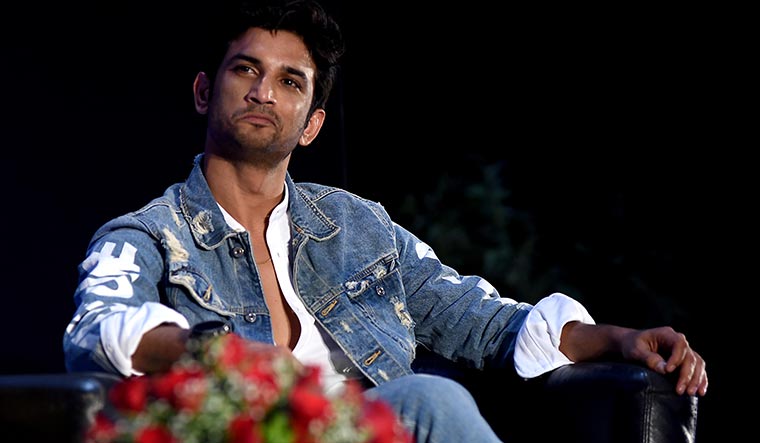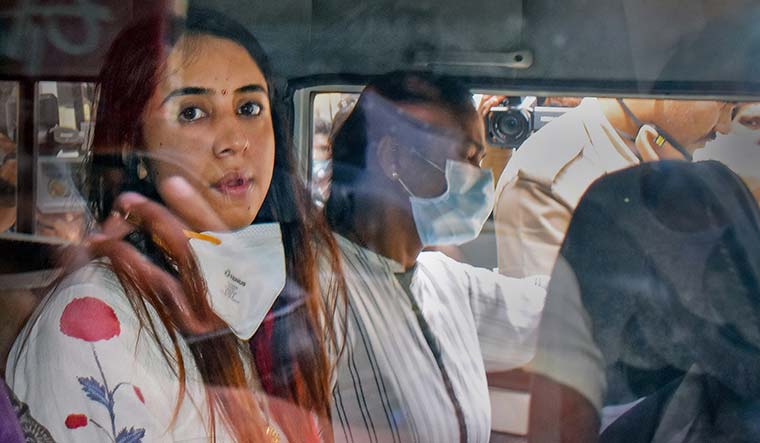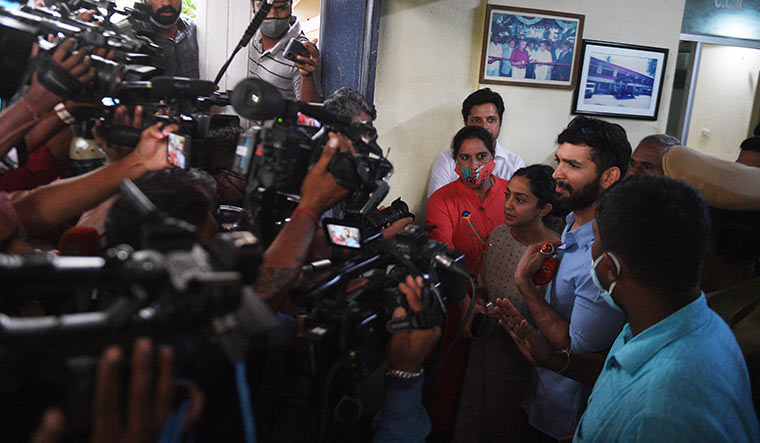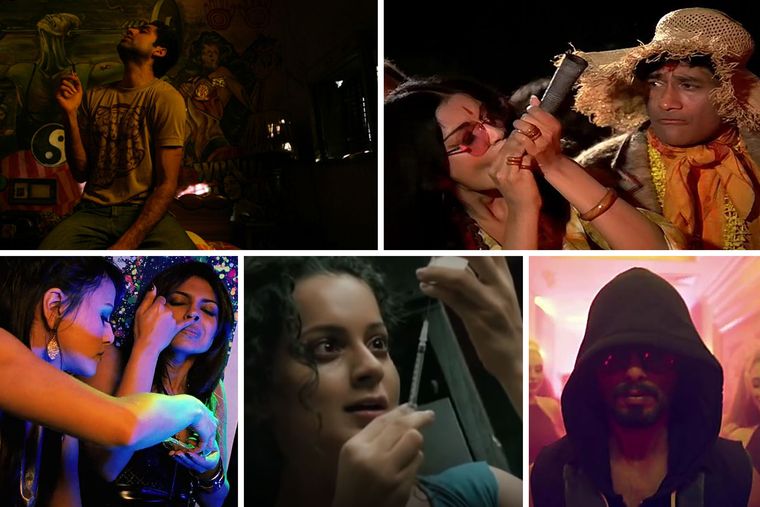The drug world, according to the Mumbai Police, uses certain codes for the banned substances. Alia Bhatt means cocaine; Anushka Sharma, hashish; Kangana Ranaut, afeem (opium); Katrina Kaif, smack; Nargis Fakhri, ecstasy; and Priyanka Chopra, LSD. “The names of drugs keep changing as it is a strategy to throw the cops off guard,” said Yashpal Purohit, a Bombay High Court lawyer who has handled several drug cases in Mumbai and Pune.
Nomenclature aside, the Narcotics Control Bureau does seem to be hot on the trail of a drug cartel that allegedly has ties with Bollywood. On September 8, the bureau arrested actor Rhea Chakraborty, the former girlfriend of the late actor Sushant Singh Rajput, under the Narcotic Drugs and Psychotropic Substances Act for procuring and consuming drugs. She is currently in 14-day judicial custody at Mumbai’s Byculla jail.
In its remand application, the NCB said that Rhea was “an active member of a drug syndicate connected with drug supplies”. It said that her WhatsApp messages indicated that she bought the drugs along with Sushant and gave instructions in this regard to his house manager Samuel Miranda, house help Dipesh Sawant and her brother Showik Chakraborty. On September 11, Rhea was denied bail. If found guilty, she could be jailed for up to ten years.
The NCB’s case hinges on 59 grams of curated marijuana found on alleged drug peddlers Abbas Ramzan Ali Lakhani and Karan Arora, who were arrested on August 28, and their alleged links with those close to Sushant. The NCB has arrested Showik, Miranda and Sawant and 15 others in the case. Rhea reportedly revealed the names of several Bollywood celebrities during interrogation, but NCB officials said these cannot be disclosed at the moment. However, an official involved in the probe said that the names would be investigated.
Sources said that Rhea also admitted to Sushant smoking weed depending on his mood and the drug’s availability. The payment, allegedly, was made from the cards of either Rhea or Sushant. NCB sources also said that Showik used to provide details of the supplier who was supposed to come outside Sushant’s house and deliver the drugs to Sawant and Miranda.
Though Rhea has reportedly admitted to communicating with all the accused to procure drugs for Sushant, her lawyer Satish Maneshinde has dismissed the allegations, saying his client was being harassed for “loving a drug addict”.
If Bollywood’s latest potboiler is playing out in news studios, other hubs of Indian film industry have their own drug-addled sagas to unpack. The past few months have seen the police swooping down on dealers, confiscating huge caches of drugs and knocking on the doors of the rich and the famous.
The Sandalwood drug scandal, for instance, jolted Bengaluru out of its pandemic slumber. Earlier this month, the central crime branch of the Bengaluru city police arrested two Kannada actors—Ragini Dwivedi and Sanjjanaa Galrani—as part of its investigation into a major drug racket.
In its first information report, the Bengaluru police named Ragini and 11 others, including the son of a former minister, who have been booked under the NDPS Act and Section 120B of the Indian Penal Code for buying, possessing, distributing and using banned drugs at rave parties, as well as for criminal conspiracy. The crime branch has been adding names to the list by interrogating arrested drug dealers.
The actors’ arrests came after the NCB’s Bengaluru unit arrested three drug dealers—former television actor D. Anikha and her associates Mohammad Anoop and R. Ravindran—on August 21. The officers confiscated a huge cache of MDMA pills and LSD blots from their homes in the city. During interrogation, Anikha allegedly admitted that she had supplied drugs to prominent Sandalwood actors and musicians, television actors, children of VIPs and college students.
Bengaluru City Police Commissioner Kamal Pant said the CCB had lately been tailing Ravi Shankar, a senior division assistant at the Regional Transport Office in Jayanagar, following a tip-off that he went to parties with a Kannada actor and supplied drugs there. “We arrested Ravi in a 2018 drug case and got a lot of information from his phone on the people linked to him,” said Pant. “His statement gave us leads for subsequent arrests.”
The crime branch learnt that drugs were being sold to the glitterati at rave parties held at resorts in Ramanagara and Bidadi, and farmhouses in Bengaluru and Tumkur. Getting an entry to these parties is quite hard, and invites are sent out at the last minute to dodge the police and the media.
The crime branch has also arrested Rahul Shetty, an architect and close friend of Sanjjanaa Galrani; Viren Khanna, a party planner; Loum Pepper Samba, a Senegalese drug peddler; Vaibhav Jain, son of a prominent jeweller in the city; and Prashant Ranka, a local drug dealer. They are looking for Aditya Alva, son of former minister Jeevaraj Alva and brother-in-law of Bollywood actor Vivek Oberoi; and the prime accused Shivaprakash, a Kannada film producer once close to Ragini. Both have absconded.
Said Joint Commissioner of Police (Crime) Sandeep Patil: “There is focused attention to break the drug network. Thousands of kilos of marijuana are being seized every year, and school and college students are turning addicts. At the same time, rave parties attended by celebrities and VIPs are providing a platform to drug peddlers to sell synthetic drugs.”
When it comes to rave parties, Goa invariably finds its way into the conversation. On the night of August 15, the Goa Police raided a rave party at a villa in Vagator village and found cocaine and MDMA pills worth Rs9 lakh. The host was Kapil Jhaveri, a small-time Bollywood actor who has been in films such as Aatma and The Love Season.
“We arrested four people for possession of drugs and 19 others for being in the house where the drugs were being consumed,” said Shobhit Saxena, superintendent of police, crime branch, Goa Police. Jhaveri and three female foreigners were arrested. A few days later, the police picked up Shailesh Shetty, co-promoter of dance music festival Sunburn, for organising the rave party, as well as the peddler who allegedly sold the drugs to Jhaveri. Both are out on bail. Incidentally, Jhaveri is on the board of directors of Tirumalla Tirupati Multistate Cooperative Credit Society, which a Goa legislator had recently accused of money laundering.
“There is nothing surprising,” said Vivek Agnihotri, director of films such as Tashkent Files and Buddha in a Traffic Jam. “Cocaine is called the champagne of Bollywood parties and glamour is essential for the syndicate to thrive and survive. Right from identifying newbies or starlets to introducing them to drugs, an entire industry works on how to get newer people hooked. Influential A-listers are roped in to encourage younger talent to take it up and very soon, unknowingly at first, one gets pulled into a syndicate. The network works on commission; the user becomes the dealer or the promoter and pushes others to become members for a cut. The reason some senior people, no matter how talented they are, do not get work in Bollywood is that they refuse to be part of this group.”
Rhea had reportedly told the NCB that 80 per cent of Bollywood actors were on drugs. And while most have been silent about their habits, actors like Ranbir Kapoor have admitted to smoking weed in their younger days. Some others, like Fardeen Khan and Vijay Raaz, have had run-ins with the law in drug-related cases. But perhaps the most open about it has been Sanjay Dutt, who has put forward his lifetime of drugs and alcohol as a cautionary tale.
The Malayalam film industry, which has garnered great applause for its path-breaking cinema, has also dealt with such demons. In fact, Mollywood’s tryst with drugs has highlighted a fissure between the “old school” artistes and their “new gen” successors. The most notable case in recent memory was that of actor Shine Tom Chacko, a promising talent, who was arrested in 2015 for allegedly possessing cocaine. There was buzz at the time that the real culprit was a prominent actor who anchors many of the ‘new gen’ movies. In fact, over the years, the raids have caught only second- or third-rung stars, if that. For instance, in May 2018, excise officers in Thiruvananthapuram arrested three Ernakulam natives for possessing hashish oil worth Rs12 crore; it was apparently meant for some A-listers in the film industry. Notably, a certain top actor hooked on hashish is said to have undergone de-addiction therapy during the recent lockdown.
Before the pandemic, a group of senior Malayalam film producers had sought an appointment with a state cabinet minister through his secretary. The secretary, who expected an outpouring of routine complaints regarding production issues or tax exemptions, was stunned to hear the producers talk about the spike in drug use on film sets. They said the behaviour of young actors was delaying schedules and hurting them financially. The producers wanted the government to take up the matter with the all-powerful Association of Malayalam Movie Artists (AMMA), many of whose top office-bearers are close to the ruling CPI(M). They gave the secretary a list of known drug users in the film industry. “The list had the who’s who of the industry,” he told THE WEEK. “New-gen actors, scriptwriters, directors... I must say I was shocked.”
Turns out, the Sandalwood drug bust had a connection with Mollywood. Mohammad Anoop, who was arrested with Anikha in August, is reportedly close to many top stars in Kerala. He used to deliver expensive drugs to night parties in Kochi, said customs officers. Apparently, a few handpicked restaurants, high-end hotels and flats are the centres from where the agents of the patrons collect the “stuff”. Gyms and spas are also known to be places of drug exchange.
“The use of drugs like LSD is common among a section of new-generation actors,” said Kerala Film Producers Association president M. Renjith. He had also voiced his concern during the recent friction between the producers’ association and young actor Shane Nigam, whom the association banned for indiscipline stemming from alleged drug use on sets.
In Tollywood, the names of top Telugu actors, directors and producers have been linked to drug networks, and police and excise officers have found their names on peddlers’ phones. In 2017, investigating officers called in a string of film folk, including top director Puri Jagannadh and popular actors Ravi Teja and Charmme Kaur. The police had found a large cache of banned substances at a peddler’s home, and he had apparently revealed the names of his star clients.
Since then, Hyderabad-based activist M. Padmanabha Reddy, who is a former IFS officer, has been filing RTI applications to know the status of the case. “The case was put on the backburner,” he said. “At the time, they had collected the nail and hair samples of the celebrities to test for banned substances. When we sought to know the results of the analysis, information was denied on the pretext that it was personal information. We got to know that film industry elders had met the chief minister and the case has almost been closed since then.”
In another case, a police officer recalled how a popular young Telugu star, in 2013, was called in and warned; his name had been cropping up whenever a Nigerian peddler was arrested. The police also suspect that some actors who shoot abroad come back with drugs. They say event managers and assistants often act as a link between the peddlers and the artistes.
Said C. Vivekananda Reddy, a retired state excise officer from Hyderabad: “The celebrities have a strange confidence owing to their star status and believe they can get away with anything. But during interrogation, they crack and their confidence dips.”
Political nexus?
Many a time, the names of politicians have surfaced in drug cases. For instance, earlier this month, the NCB summoned Yashas, the son of a Bengaluru councillor S. Keshavamurthy, to Mumbai, in connection with the Sandalwood drug case. However, rarely has a politician been punished in any such case. In fact, there have for long been whispers about a Congress legislator in Karnataka having links to drug peddlers with international connections, especially in Sri Lanka, where Indian film stars frequent casinos known to be dens of drug activity.
In 2017, police recovered drugs from a luxury car that had had an accident near South End Circle in Bengaluru, but the case did not progress. Reportedly, the car belonged to a former MP’s grandson. Former chief minister H.D. Kumaraswamy has even alleged that the BJP toppled the Janata Dal (Secular)-Congress government in 2019 using drug mafia money. The Congress has attacked the BJP over the arrest of Ragini; the actor had been a star campaigner for the BJP during the 2019 assembly byelections.
In Kerala, the police suspect the involvement of Bineesh Kodiyeri, son of CPI(M) state secretary Kodiyeri Balakrishnan, in the Sandalwood drugs case. On September 9, the Enforcement Directorate questioned Bineesh, who has had cameos in a few films, for more than 10 hours. He is reportedly friends with the arrested Anoop. “Bineesh loves the limelight,” said a source. “He demanded roles in movies in return for the ‘services’ he provided.”
Many in the Malayalam industry have also linked the unusually high number of movies being produced to drugs and black money. As many as 167 films were produced in 2019 alone, and the figure has consistently crossed 150 in every year of the past decade. Interestingly, most of the producers were newcomers, and the ED has reportedly sought details of all films produced by the industry in the past two years.
Industry hypocrisy
On September 15, Samajwadi Party MP and actor Jaya Bachchan told Parliament: “Just because of a few people, you cannot tarnish the whole industry.... I was really embarrassed and ashamed that yesterday one of our members in the Lok Sabha, who is from the industry, spoke against the film industry.” She was referring to a statement BJP MP and actor Ravi Kishan had made about the prevalence of drug use in the film world.
The Indian film industry has often been called out for being hypocritical in its response to allegations of drug abuse. The usual reaction has been denial and disbelief in public, and a meek acknowledgement in private conversations.
Kannada film producer and journalist Indrajit Lankesh, however, openly spoke about several actors “consuming drugs” at rave parties. “(After the NCB made the arrests in late August) I gave the crime branch around 20 names of actors, actresses, sons of film directors and politicians, event managers and coordinators, based on the information I received from my sources in the industry,” he said. “It is now up to the investigating agency to find enough evidence to arrest all the culprits.”
The Karnataka Film Chamber of Commerce had been in denial until the two female actors were arrested. While some have since expressed shock, others argued that Sandalwood was being unfairly “targeted” and that drug abuse was rampant in society. Some also complained of “misogyny” after the police arrested only the female actors.
“Many people are questioning the timing of my statements,” said Lankesh. “It is just the law of incidence. I have seen indiscipline issues among some actors who have turned up on sets in a bad state. Some newbies are treating films as a hobby rather than a profession. It will be hypocritical not to address the issue. A dialogue has to start, to tackle the drug menace. The arrests will act as a major deterrent for students getting lured by ganja and cocaine, as they will realise that consuming drugs is illegal and punishable.”
Pointing to the leadership vacuum created by the deaths of veterans such as Rajkumar and Ambareesh, former film chamber president Sa Ra Govindu said: “We want to clean up the industry and we cannot allow a handful of people to ruin the legacy of an industry that was built by stalwarts.”
The older generation in Kerala has bemoaned the “caravan culture” of the past decade. “Earlier, everyone from the hero to the spot boy used to be together on set,” said a senior actor. “But now, most actors have their own caravans and they step into it once their portion is over. Nobody knows what happens inside.”
It seems there is more discipline on the sets when veteran stars such as Mammootty and Mohanlal are part of a production. “They are so different from the current ‘powder generation,” he said. Added a Mollywood producer: “Most of them (new-gen artistes) are in their early thirties now. Some who cannot handle success or money became addicts.”
The topic of drugs has triggered a war of words between generations. While the old-school artistes call the newer lot the “powder gen”, the youngsters label the veterans as “boozers”. “The old generation had heavy drinkers. They did not take drugs because drugs were not easily available,” said a new-gen scriptwriter. Many actors and scriptwriters THE WEEK spoke to said they were open to using drugs and even argued for a “liberal approach”. “Many in the Malayalam film industry use drugs,” admitted an actor-director. “But do not make it sound as if it exists only in the film industry. Aren’t there drugs in colleges, offices? It becomes an issue only when it leads to abuse. Unlike MDMA, weed or magic mushrooms have no side effects. Cannabis is legal in many countries. It is time weed is legalised.”
In Tamil Nadu, a clutch of senior Kollywood stars, along with a young music composer, are called the “powder boys”. Police sources said the stars network with the drug cartel, the cinema industry in Chennai and some industrialist families in the state. “They source and supply; hence the nickname,” said a senior officer at the DGP office in Chennai.
A. Bruno, the zonal director of the Narcotics Control Bureau, Chennai, said the rave parties usually had MDMA pills. The late-night parties that once happened in Chennai’s star hotels have moved to the East Coast Road, he added. The parties get their customers through the dark web, client references and video game tournaments, which are also organised by the drug pushers. MDMA, usually in powder form, costs 03,000 a gram, and is either sniffed or rubbed on the wrist. Many actors are said to use it as a stimulant to help them perform better. Half a gram of MDMA can keep one awake all night, said Bruno.
The Telugu film industry has not taken too kindly to the bad press it has been receiving. Jeevitha Rajasekhar, general secretary of Telugu Movie Artists Association, said that even though drug consumption was a major problem, only the film industry got the blame. “Drugs are bad and actors are supposed to be role models. I agree with that,” she said. “But why are only film industry members pushed to the forefront? We want the governments to put an end to this menace. At the same time, as an industry, we do not want to be the face of the menace.”
The perception battle
In older movies, drug use was portrayed as a social evil, practised only by the villain and his coterie. Now, though, the image of a drug user has been softened to some extent. A lot of films even show the hero smoking up for pleasure. A case in point is the 2013 Malayalam movie Kili Poyi, said to be the industry’s first stoner movie. “This change in the depiction of drugs is reflective of the new ethos of the film industry in particular, and the larger society in general,” said film critic Sajitha O.C.
Kannada actor and social activist Chetan Kumar made a separate point. He tweeted: “While the current focus is on exposing film personnel/actors who use #drugs privately… Isn’t it hypocritical to not point fingers at film ‘stars’ who, for money, openly advertise alcohol (as soda), gutka/pan masala, gambling (rummy), etc? Aren’t they ‘ambassadors’ of social evils?”
Said Harmanpreet Kaur, assistant professor at Tata Institute of Social Sciences: “Art is inspired by society. It is interesting to note the portrayal of drug use/substance abuse in Hindi cinema over the decades. Hare Rama Hare Krishna (1971) with its hit number ‘Dum Maro Dum’ reflected hippie culture and portrayed drug use as a vice. The hero rescuing his sister from it carried a strong anti-drug message. Many films portrayed cannabis/bhang use in a jovial manner through songs, be it ‘Jai Shiv Shankar’ (Aap ki Kasam, 1974) or Holi songs like ‘Rang Barse’ (Silsila, 1981).”
Contemporary Hindi films have also shown characters doing drugs, like in Dev.D (2009), Udta Punjab (2016) and Raman Raghav 2.0 (2016). Fashion (2008) is another example in which Kangana Ranaut starred as a model ruined by drugs. Incidentally, she has now been tweeting against Bollywood’s “drug abuse problem” even as a video of her claiming that she used to be a drug addict herself, has gone viral on Twitter.
Regardless of whether the fresh cases lead to further arrests or bring down cartels, it is clear that the various ‘woods’ of Indian cinema, be it Bolly, Sandal or Molly, have a spreading drug problem. And change, it seems, can only come from within.
To modify the famous lines of Robert Frost: “The woods are ugly, dark and deep, and they have some secrets to keep.”
—with Namrata Biji Ahuja
















